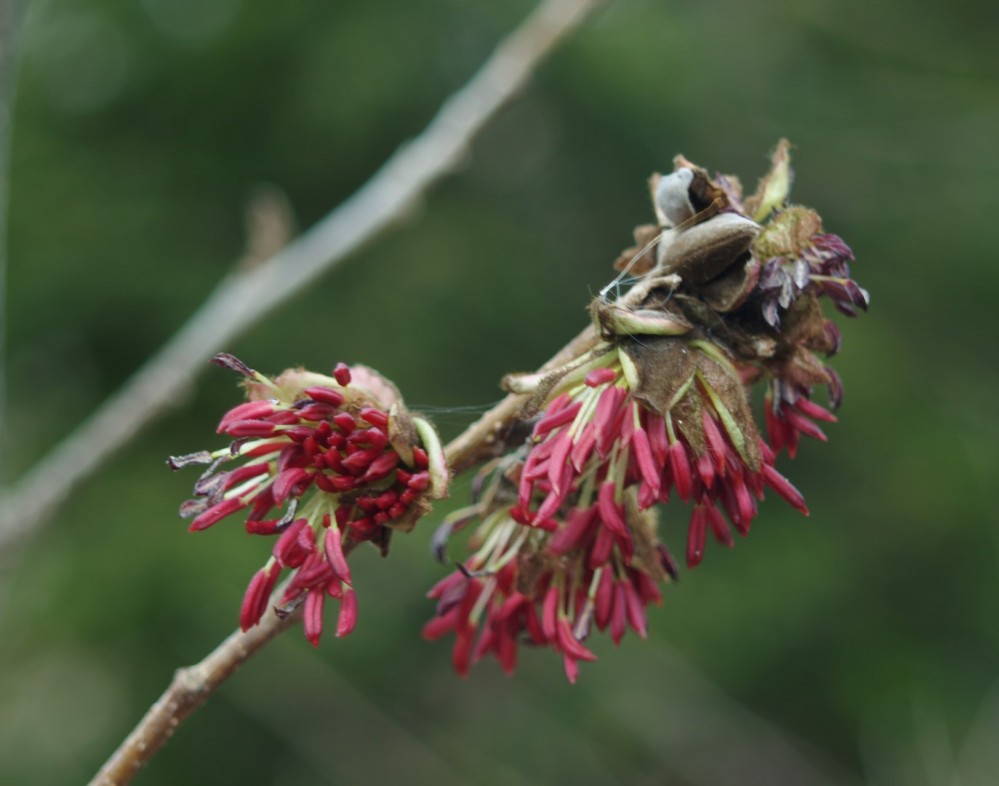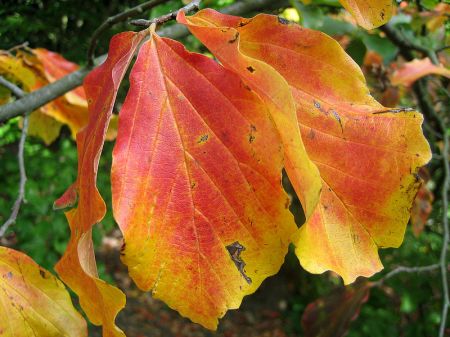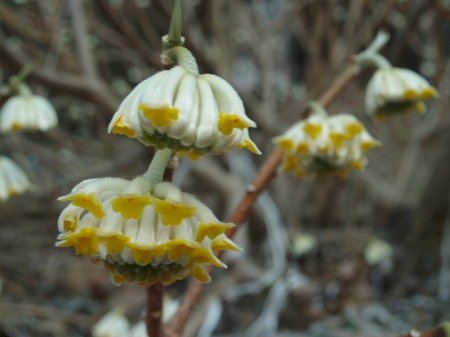For the first time since I planted the Persian ironwood (Parrotia persica, sometimes referred to as Persian witch hazel, below) I’ve seen its unusual blooms. Parrotia is in the witch hazel family (Hamamelis), and the flowers are somewhat similar to other witch hazels. This tree was a late addition to the garden, planted long after prime positions for a tree so grand were taken, so that the Parrotia has been planted in too shady a spot. With limited sunlight and moisture robbed by nearby shallow rooted maples, the tree grows with a notable lack of vigor.
The blooms in mid March are sparse, and clustered to the one side that receives the most sunlight whenever it is that the flower buds are formed. This changes to varying degrees through the year depending on the sun’s path, but the Parrotia is shaded enough that the splendid autumn foliage color is also diminished.
A wiser gardener would have planned a spot to provide the Parrotia with more sun, but that would mean that something else would have to go, and rarely is any plant expendable in this garden as long as there is an open inch of ground. Long term planning is not my priority, and since the tree is surviving I’ll presume that all is well, and that the tree will gain a foothold and its health will improve in the next few years. I could help it along by cutting out some of the lower branches of the oaks and maples that border this part of the garden, though there’s not much to be done about the lack of moisture.
I have lost more than a few treasures through the years due to careless planting, but many more have survived to confirm to me that plants are often much tougher than you expect. A sturdy plant will often persevere through neglect and abuse with the slightest amount of attention, and this is the plan for the Parrotia. It’s been in the ground for a couple years now, so the worst is over unless I allow branches from neighboring trees to overhang and shade it further. Lopping off even a few of the branches from the nearby oak is likely to be all that’s needed.
So, it appears that we’ve settled this matter. All that’s needed is to drag the ladder to the back of the property to climb to remove the few lowest branches, and next year in late winter a bounty of marvelous red blooms will be expected.
Many gardeners favor plants that are a bit out of the ordinary, and another less than common shrub in the witch hazel family has become one of my favorites. In fact, most plants in the witch hazel family are exceptionally worthy garden plants, and that they are not overly common makes them all the more wonderful. Paperbush (Edgeworthia chrysantha, above) should be planted more widely, but I rarely see it available, and I find it difficult to understand why.
Some winter flowering shrubs are not so popular as they should be because they bloom just a bit too early for garden center customers to see the flowers, but paperbush flowers at the start of the prime spring season. In any case, I’m happy to have planted four small shrubs several years ago that have grown to nearly ten feet across, and in mid March each has many hundreds of white tubular blooms, tipped with butter-yellow.
The flowers are fragrant, though I feign to notice any scent at all, and certainly the fragrance is not as strong as any of the garden’s witch hazels. But, there is no shrub in the garden with more abundant blooms, which stand out ever more since they are carried on bare stems. If paperbush flowered in late April, with azaleas and camellias and so much more, it would still be lovely, but blooming at the end of a dull, gray winter the flowers are considerably more delightful.
I’ve been known to over plant on occasion, and in my zeal I planted two clumps of three small paperbushes just prior to winter when I was sorting out what should go where after limbing up a declining spruce and removing brush and brambles at the front corner of the garden. The plants were available, and there must be some place to fit them in, so this spot will do just fine until they get a bit of size on them. I’m afraid that the spruce will continue to go downhill, and that sooner than later it will need to be removed completely. How I will go about this with two large clumps of paperbush to either side I don’t know, but there’s plenty of time to sort out such matters, and in the meanwhile I don’t believe it is possible to have too much of such an extraordinary shrub.
The blooms are one warm weekend away from their prime, and even if warm days are not imminent the flowers should be fully opened in another week. With cool temperatures I would not be surprised to see the paperbushes still in bloom with azaleas near the end of April. With many flowers delayed by the cold of recent weeks April will be quite spectacular. A year ago spring flowers began in February, and a few even in late January, but all are being pushed back several weeks late so the blooming season will be compressed. I’m looking forward to it!
Dave,
Have you ever experimented with “compost tea” in your garden? I am researching organic gardening and the use of compost tea seems to be a stable of many organic gardeners, though there is not much scientific research to confirm/deny its use. I would tend to trust some anecdotal evidence from such an experienced gardener as yourself!!!
No, I haven’t used compost tea. I rarely fertilize or use anything to rid the garden of pests, so I’ve never given it a thought. However, I have read research that counters the claims of compost tea’s benefits. It seems much easier to top dress with compost rather than wasting effort concocting this brew.